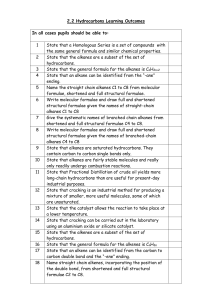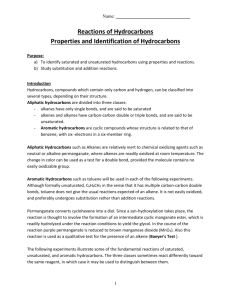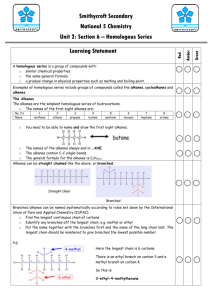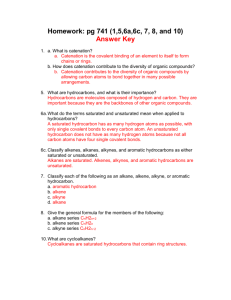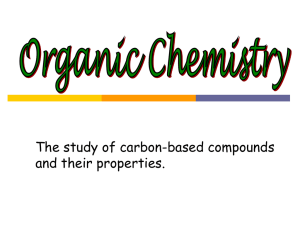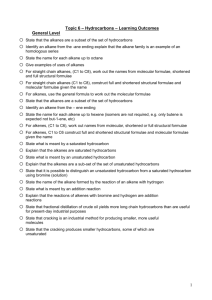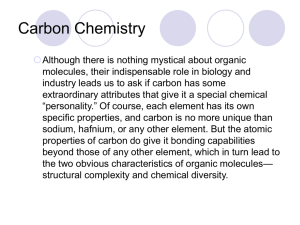Unit 3 Document
advertisement
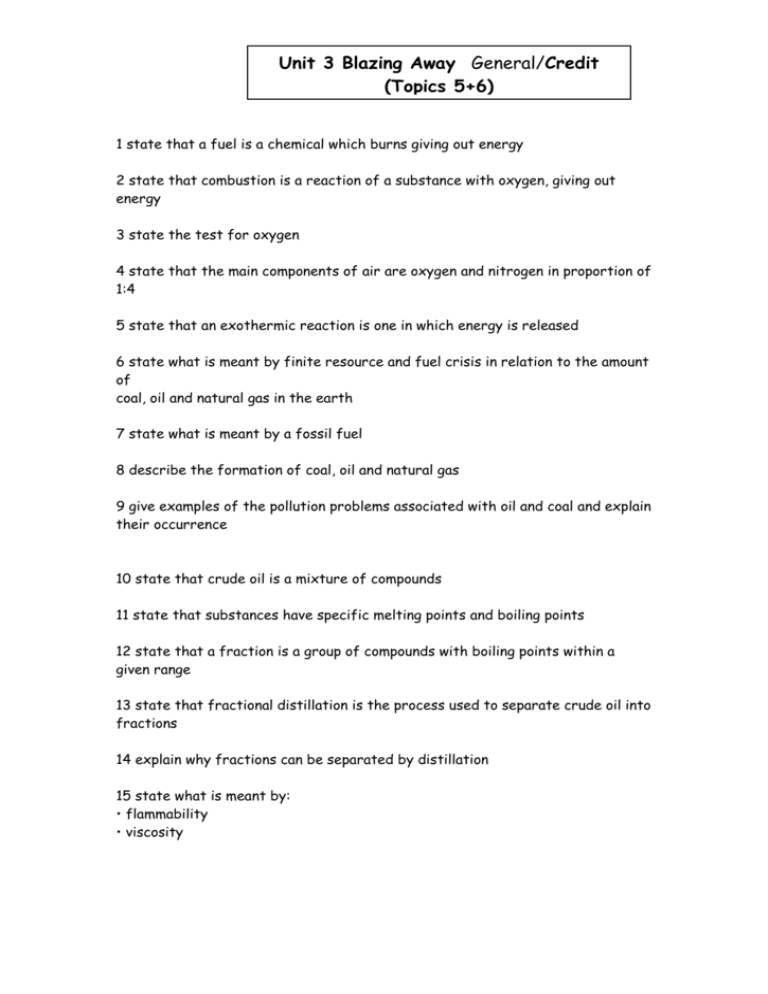
Unit 3 Blazing Away General/Credit (Topics 5+6) 1 state that a fuel is a chemical which burns giving out energy 2 state that combustion is a reaction of a substance with oxygen, giving out energy 3 state the test for oxygen 4 state that the main components of air are oxygen and nitrogen in proportion of 1:4 5 state that an exothermic reaction is one in which energy is released 6 state what is meant by finite resource and fuel crisis in relation to the amount of coal, oil and natural gas in the earth 7 state what is meant by a fossil fuel 8 describe the formation of coal, oil and natural gas 9 give examples of the pollution problems associated with oil and coal and explain their occurrence 10 state that crude oil is a mixture of compounds 11 state that substances have specific melting points and boiling points 12 state that a fraction is a group of compounds with boiling points within a given range 13 state that fractional distillation is the process used to separate crude oil into fractions 14 explain why fractions can be separated by distillation 15 state what is meant by: • flammability • viscosity 16 give examples of how the products of fractional distillation of crude oil can be used state the typical range of chain length of the molecules in each fraction and relate this to their use 17 describe how each of the following varies for fractions of different boiling points: • evaporation • flammability • viscosity explain in terms of molecular size the change in each of the following: • boiling point • flammability • viscosity 18 state that the chemical compounds which are found in oil and natural gas are mainly hydrocarbons 19 state that a hydrocarbon is a compound which contains hydrogen and carbon only 20 state the tests for carbon dioxide and water 21 state that hydrocarbons burn completely to produce only carbon dioxide and water explain why the production of carbon dioxide and water, on burning, indicates the presence of carbon and hydrogen in the original fuel 22 state that carbon, and carbon monoxide, a poisonous gas, are produced when the hydrocarbons burn in a supply of oxygen which is insufficient for complete combustion 23 state that the burning of some fuels releases sulphur dioxide, a poisonous gas, to the atmosphere 24 state that removing sulphur compounds reduces air pollution 25 state that nitrogen and oxygen from the air react inside a car engine to form nitrogen oxides (poisonous gases) 26 state that lead compounds which are added to petrol cause pollution 27 state that air pollution from the burning of hydrocarbons can be reduced by special exhaust systems or by altering the fuel to air ratio explain that transition metal catalysts can convert the pollutant gases to harmless gases 28 explain that decreasing the fuel to air ratio improves the efficiency of combustion thus decreasing pollution. 1 state that the alkanes are a subset of the set of hydrocarbons state what is meant by a homologous series 2 identify an alkane from the -ane ending explain that the alkane family is an example of a homologous series 3 state the name for each alkane up to octane 4 give examples of uses of alkanes 5 for straight chain alkanes, (C1 to C8), work out the names from molecular formulae, shortened and full structural formulae 6 for straight chain alkanes (C1 to C8), construct full and shortened structural formulae and molecular formulae given the name 7 for alkanes, use the general formula to work out the molecular formulae derive a general formula for alkanes 8 explain in terms of increasing molecular size why the boiling point increases as the number of carbon atoms in an alkane increases 9 state the name of each cycloalkane up to cyclohexane 10 explain that the cycloalkane family is an example of a homologous series 11 state what is meant by isomers 12 state that the alkanes are a subset of the set of hydrocarbons 13 identify an alkene from the – ene ending 14 state the name for each alkene up to hexene (isomers are not required, eg only butene is expected not but-1-ene, etc) explain that the alkene family is an example of a homologous series 15 for alkenes, (C1 to C6), work out names from molecular, shortened or full structural formulae 16 for alkenes, C1 to C6 construct full and shortened structural formulae and molecular formulae given the name 17 for alkenes, us a general formula to work out molecular formulae derive a general formula for alkenes 18 identify from a structural formula the following types of compound: alkanes and alkenes for simple organic molecules, including alkanes,alkenes and clycloalkanes, construct appropriate isometric forms, given a molecular formula 19 state what is meant by a saturated hydrocarbon 20 explain that the alkanes are saturated hydrocarbons 21 state what is meant by an unsaturated hydrocarbon 22 explain that the alkenes are a sub-set of the set of unsaturated hydrocarbons 23 state that it is possible to distinguish an unsaturated hydrocarbon from a saturated hydrocarbon using bromine (solution) 24 state the name of the alkane formed by the reaction of an alkene with hydrogen 25 state what is meant by an addition reaction 26 explain that the reactions of alkenes with bromine and hydrogen are addition Reactions 27 state that fractional distillation of crude oil yields more long chain hydrocarbons than are useful for present-day industrial purposes 28 state that cracking is an industrial method for producing smaller, more useful molecules 29 state that the catalyst allows the reaction to take place at a lower temperature 30 state that the cracking produces smaller hydrocarbons, some of which are unsaturated explain why cracking produces a mixture of saturated and unsaturated products.

